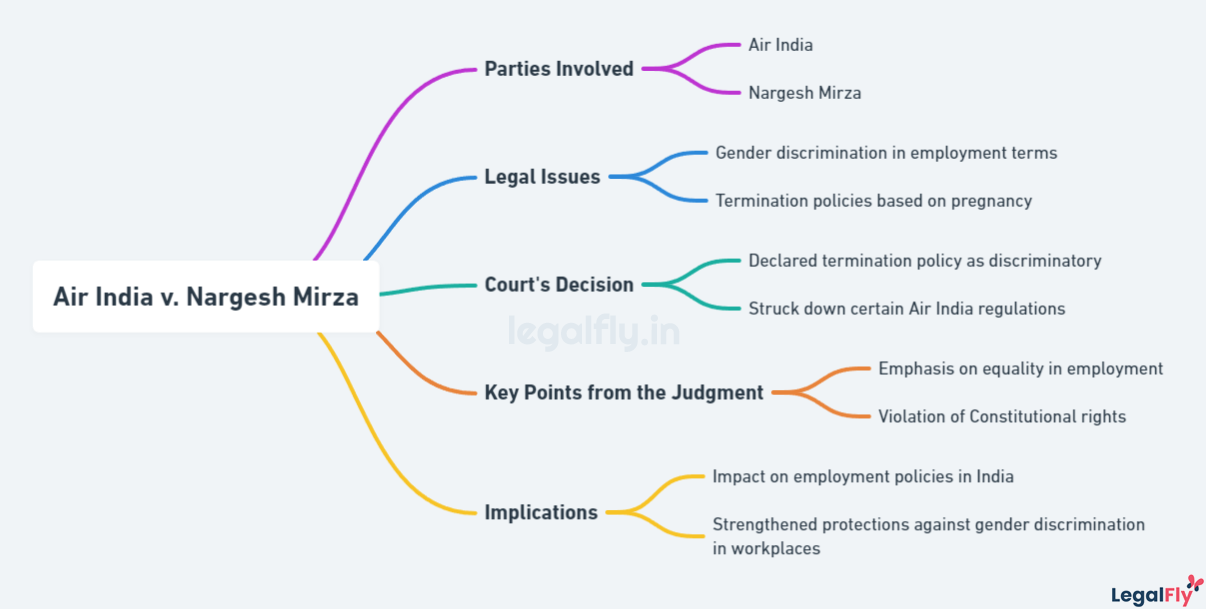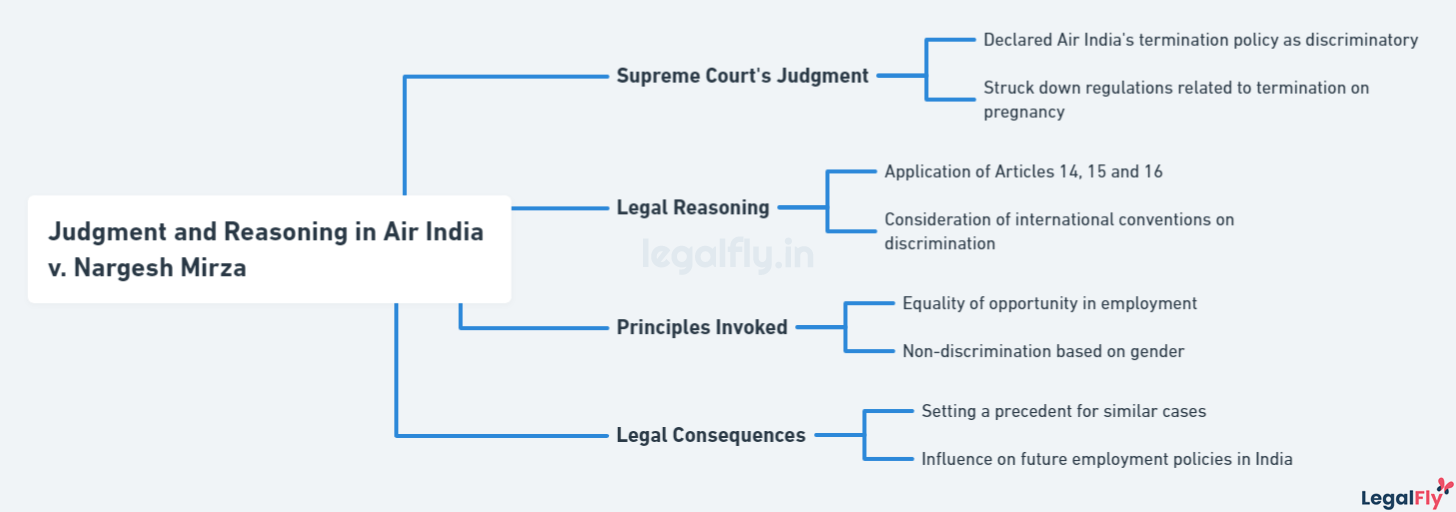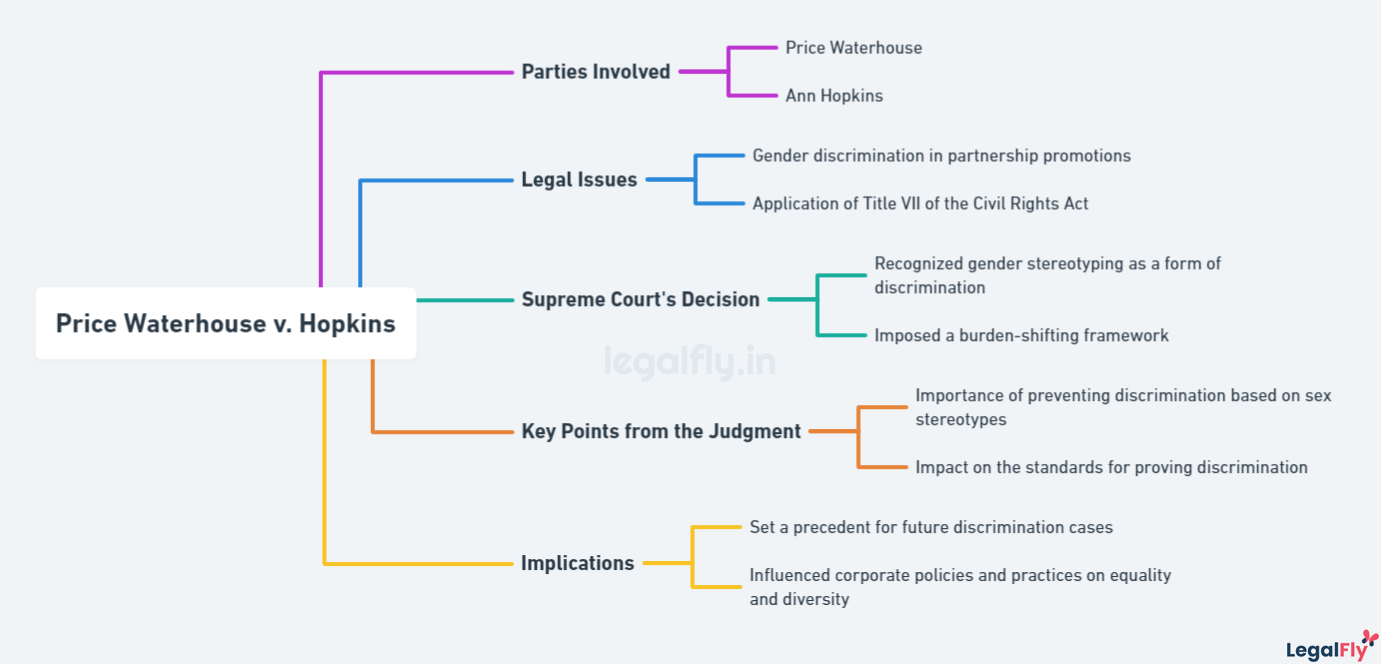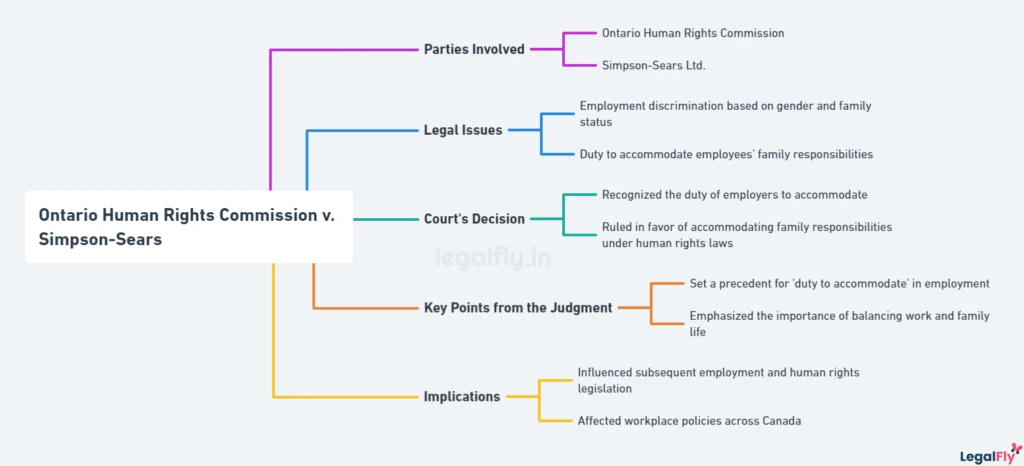Case Name: Air India Etc. Etc vs Nergesh Meerza & Ors. Etc. Etc
Court: Supreme Court of India
Year: 1981
Citation: 1981 AIR 1829, 1982 SCR (1) 438, 1981 SCC (4) 335
Table of Contents
Introduction: The Case That Challenged Gender Norms
Air India v. Nargesh Meerza is a landmark case in Indian legal history that challenged discriminatory policies based on gender norms. The case was filed in 1981 by Air India flight attendant Nargesh Meerza after she and other female flight attendants were forced to resign from their jobs once they got married, which did not apply to male flight attendants.
The case highlighted how workplace policies grounded in gender stereotypes violated constitutional principles of equality. It raised questions about the fundamental right to equality under Article 14 and the prohibition of discrimination under Article 15 of the Indian Constitution. At its core, the case contested whether policies mandating women to resign after marriage were unreasonable and arbitrary.

The case gained national prominence, representing the struggle against deeply entrenched gender roles that limited women’s rights. By challenging Air India’s discriminatory policies, the case sought to expand equal opportunities for women in the workplace. It paved the way for defining the constitutional basis for gender equality in India.
Background of Air India v. Nargesh Meerza
Air India v. Nargesh Meerza was a landmark case in Indian legal history that challenged discriminatory workplace policies on the basis of gender. The case emerged in the context of regulations instituted by Air India that imposed restrictive conditions on its female flight attendants.
The petitioner, Nargesh Meerza, was an Air Hostess with Air India Airlines. As per Air India’s regulations at the time, female flight attendants were required to resign upon marriage, their first pregnancy, or upon reaching the age of 35, whichever occurred earliest. Male flight attendants did not face similar restrictions.
Nargesh Meerza challenged these regulations by filing a writ petition in the Bombay High Court in 1980. She contended that the regulations presented unreasonable impediments to women employees and were discriminatory under Articles 14, 15 and 16 of the Indian Constitution. Articles 14 and 15 guarantee equality before law and prohibit discrimination on grounds of religion, race, caste, sex or place of birth. Article 16 guarantees equality of opportunity in public employment.
Air India justified its differential policies for women, citing factors like the risk of unemployment upon pregnancy, safety concerns, passenger expectations, and flight irregularities caused by pregnancy. However, Meerza argued that these did not present a reasonable classification between male and female employees.
The case highlighted the deep-rooted gender bias and stereotyping prevalent in Indian corporations at the time. Meerza’s legal challenge paved the way for scrutiny of discriminatory workplace policies under constitutional provisions of equality and non-discrimination.
Legal Challenges and Constitutional Questions
Nargesh Meerza challenged the termination of her employment as an air hostess by Air India as unconstitutional and discriminatory. She argued that Air India’s service rules requiring air hostesses to retire or resign upon marriage or first pregnancy violated her fundamental rights to equality under Article 14 and Article 15 of the Indian Constitution.
Meerza’s lawyers contended that Air India’s service regulations unfairly discriminated on the basis of sex by imposing restrictive conditions only on female employees. They invoked the right to equality before law and prohibition of discrimination on grounds of religion, race, caste, sex or place of birth under the Constitution. It was argued that the service rules were based on archaic notions about women’s role in society and perpetuated gender stereotyping.
Air India violated Meerza’s fundamental rights by terminating her employment due to marriage. The service regulations did not impose similar restrictive conditions on male employees regarding marriage or parenthood, so they were discriminatory and unconstitutional. Meerza’s legal team asserted that personal decisions regarding marriage or children should not affect a woman’s employment status or opportunities. The regulations contravened principles of workplace equality regardless of gender.
Supreme Court’s Judgment and Reasoning
The Supreme Court struck down Air India’s discriminatory service conditions as unconstitutional and arbitrary. The Court held that the requirements constituted “hostile discrimination“, violating Articles 14, 15 and 16 of the Constitution.
The Court reasoned that the service conditions were based on stereotypical assumptions about female flight attendants and did not rationally relate to the job’s duties. Requiring women to retire earlier than men and restricting their opportunities for promotion were unjustified.

The judgment established that policies discriminating on the basis of sex violate fundamental rights. It expanded the scope of equality under the law, emphasizing that equality must exist between persons similarly situated in employment. The Court asserted that service conditions must have a rational nexus to the requirements of a job rather than being based on arbitrary standards.
By striking down these policies, the Supreme Court affirmed constitutional protections against gender discrimination in the workplace. The judgment set an important precedent in Indian law upholding gender equality.
Impact of the Judgment on Gender Equality
The Supreme Court’s ruling in Air India v. Nargesh Meerza had a significant impact on advancing gender equality in India. The case challenged discriminatory workplace regulations that forced air hostesses to resign from their jobs after marriage or first pregnancy. By striking down these regulations as unconstitutional, the judgment affirmed women’s right to equality in employment under Article 14 of the Constitution.
The case was a landmark in eliminating gender bias in the workplace and established an important precedent against policies that stereotype women. It influenced many private and public sector organizations to reform discriminatory policies and provide equal opportunities for female employees. The judgment catalyzed further evolution of gender rights in India, paving the way for greater workplace equality.
Impact on Workplace Equality in India
The judgment in Air India v. Nargesh Meerza significantly impacted workplace equality in India, leading to changes in corporate policies and the elimination of similar discriminatory practices. However, some challenges remain.
The judgment set a strong precedent against gender discrimination in the workplace. Many companies that had similar discriminatory policies were forced to change them after the ruling. Air India had to revise its regulations and end its policy of requiring female flight attendants to retire earlier than male flight attendants. Other airlines, like Indian Airlines, also eliminated rules that imposed restrictions, dress codes, or early retirement solely on female cabin crew members.
More broadly, the judgment influenced corporate policies beyond just the airline industry. It established gender equality as a constitutional right and made clear that policies based on gender stereotyping would not withstand legal scrutiny. Many companies reviewed and revised their HR policies on recruitment, promotions, benefits, retirement age, etc., to eliminate differential treatment.
However, workplace equality remains a challenge in India even today. Pay gaps, lack of women in leadership roles, and subtle discrimination persist. The judgment was an important milestone, but much work remains to achieve complete equality. Ongoing advocacy, evolving case law, and changing attitudes are still needed to create workplaces where men and women enjoy the same rights and opportunities.
Gender Discrimination and Legal Safeguards
The Air India v Nargesh Meerza case brought national attention to gender discrimination in the workplace in India. In the years following the landmark judgment, the government enacted new laws and amended existing ones to strengthen legal safeguards against gender bias.
Some key developments included:
- The Equal Remuneration Act of 1976 mandated equal pay for equal work. This was a significant step in ensuring wage parity between men and women.
- The Sexual Harassment of Women at Workplace (Prevention, Prohibition and Redressal) Act of 2013 provided guidelines for the prevention and redressal of sexual harassment complaints, ensuring women’s safety and dignity at the workplace.
- Court judgments like Vishaka v State of Rajasthan (1997) laid down guidelines for dealing with sexual harassment until the 2013 law was enacted.
While the legal framework has expanded considerably, challenges remain in fully realizing gender equality at the workplace. Laws are not always effectively implemented, and deeply entrenched patriarchal social norms continue to foster discriminatory attitudes. Employers need to take more proactive measures, conduct awareness campaigns, and enforce strict laws to make workplaces truly equal and inclusive. The evolution of gender justice remains a work in progress in India.
Comparisons with Global Workplace Rights
Similar prominent cases in other countries include:
- Price Waterhouse v. Hopkins in the United States, where the Supreme Court ruled that sex stereotyping is actionable as sex discrimination under Title VII of the Civil Rights Act of 1964. This established that discrimination based on not conforming to gender norms is illegal.

- Ontario Human Rights Commission v. Simpson-Sears in Canada, where the Supreme Court upheld that the employer’s policy of excluding women from commission sales jobs constituted sex discrimination under the Ontario Human Rights Code.

Comparative analysis of the judgments and outcomes shows that courts in different countries have recognized various forms of gender discrimination as being illegal and unconstitutional. While the specifics differ based on local laws, there is a clear global trend towards workplace equality and eliminating discrimination based on gender norms and stereotypes. However, despite legal safeguards, gender equality in the workplace remains an ongoing challenge worldwide. Air India v. Nargesh Meerza was an early landmark case in establishing principles of gender justice under Indian law that reflected global progress.
Conclusion: The Legacy of Air India v. Nargesh Meerza
The landmark Supreme Court judgment in Air India v. Nargesh Meerza in 1981 was a defining moment in India’s legal battle against gender discrimination in the workplace. Though not a comprehensive victory, it laid the foundation for greater workplace equality for women in the decades that followed.
The case challenged the constitutional validity of Air India’s regulations that allowed for the termination of female flight attendants if they got married within four years of service or if they became pregnant. Though Air India argued these restrictions were justified, the Supreme Court ruled they were arbitrary and violated fundamental rights.
The judgment established that service rules based solely on gender violated Articles 14, 15 and 16 of the Constitution relating to the right to equality and non-discrimination. It affirmed women’s right to employment and personal liberties regardless of marital status. The Court rejected stereotyped notions that married women or mothers could not effectively continue employment.
However, the Court did not entirely strike down the impugned service rules. It only removed the provisions related to marriage and pregnancy, allowing other discriminatory conditions to remain. The battle for workplace equality was only partly won.
Nevertheless, the Meerza case created an important legal precedent against sex-based discrimination in employment in India. It led to changes in corporate policies that previously mandated women to resign after marriage or childbirth. Over the decades, more women have joined the public and private sector’s workforce.
Yet gender disparities and unfair policies persist in many areas. Cases of pregnancy discrimination, unequal pay and lack of work-life balance options affect women professionals. The quest for gender-just workplaces remains an ongoing struggle. The legacy of the Air India v. Nargesh Meerza case is a reminder that the foundations have been laid, but the mission remains incomplete.




